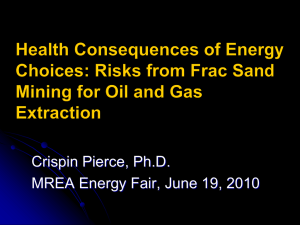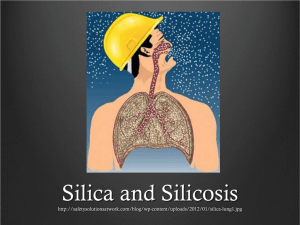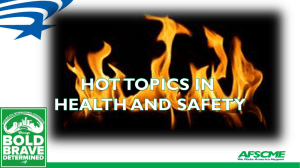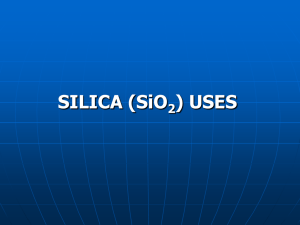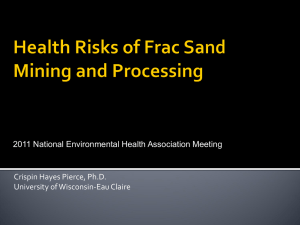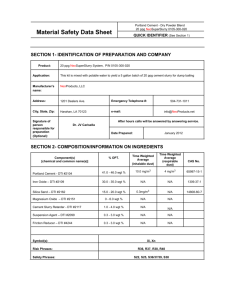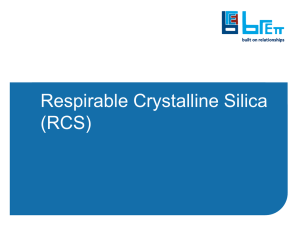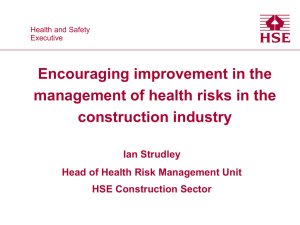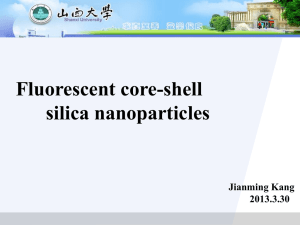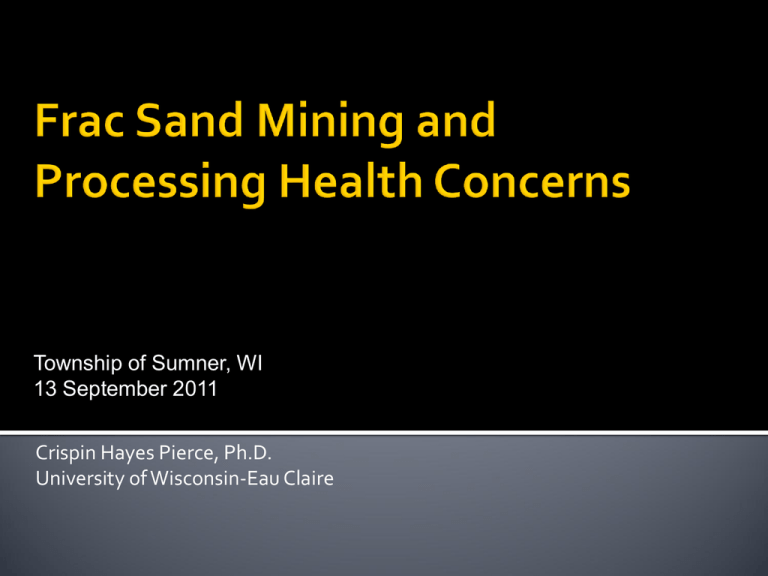
Township of Sumner, WI
13 September 2011
Crispin Hayes Pierce, Ph.D.
University of Wisconsin-Eau Claire
Overview of Risks
Complexity of Health Risk Assessment
Sand Mining and Processing
Particulate Matter
Crystalline Silica
Health effects
Particle Size is Important
WDNR Non-Regulation of Silica
Recommendations
Waterborne pollutants that can be ingested.
Airborne pollutants that can be inhaled.
Noise pollution that can be heard.
Light pollution that can be seen.
Wetland loss that affects local water quality.
Truck traffic that affects road safety.
Greenhouse gas generation that increases
climate change.
A potential benefit is that methane produces
fewer greenhouse gas emissions per unit of
energy when used as an energy source
compared to coal or oil.
However, if this methane is released into the
atmosphere from drilling or leaking wells, it
negatively contributes to climate change
Many factors contribute to the potential
health risks from an industrial operation:
The type and rates of chemicals being emitted to
the air, water, and soil.
The degree of contact between these chemicals
and the public.
The way that these chemicals cause short-term
and long-term damage to people.
Sand and Gravel Quarry Activities
Sand Conveying
Sand Processing Plant
Hydraulic Fracturing Operation
Increased respiratory symptoms, such as
irritation of the airways, coughing, or difficulty
breathing, for example;
Decreased lung function;
Aggravated asthma;
Development of chronic bronchitis;
Irregular heartbeat;
Nonfatal heart attacks; and
Premature death in people with heart or lung
disease.
The mining and processing activities
generate PM through mining, transporting,
and processing “frac sand”; and transporting
“waste sand.”
Health Effects
Silicosis –a fibrosis (scarring) of the lungs.
Silicosis is progressive and leads to disability
and death.
About 200 people in the US will die this year
due to workplace exposure to silica (NIOSH
2008).
Silicosis: Crude mortality rates by state, U.S. residents age 15 and
over, 1991-1992.
SOURCE: National Center for Health Statistics multiple cause of death data.
Population estimates from U.S. Bureau of the Census.
http://www.cdc.gov/niosh/docs/96-134/pdfs/96-134e.pdf
The National Institute for Occupational
Safety and Health reported 75 deaths in
Wisconsin between 1996 and 2005 from
silicosis, primarily among workers in
manufacturing, construction and mining
(Smathers, 2011).
Between 8-18 people are expected to die in
Wisconsin from silicosis in 2011.
Lung Cancer – Crystalline silica (quartz) is
classified as a human carcinogen by the
following regulatory agencies:
International Agency for Research on Cancer (IARC)
National Toxicology Program
California Proposition 65
American Conference of Governmental Industrial
Hygienists
Occupational Safety and Health Administration Potential Cancer Hazard
National Institute for Occupational Safety and
Health (NIOSH) – Potential Cancer Hazard
Tuberculosis – Silicosis increases the risk of
tuberculosis.
Autoimmune and Chronic Kidney Disease – Some
studies show excess numbers of cases of scleroderma,
connective tissue disorders, lupus, rheumatoid
arthritis, chronic kidney diseases and end-stage
kidney disease.
Non-Malignant Respiratory Diseases (other than
Silicosis) – Some studies show an increased incidence
in chronic bronchitis and emphysema in workers.
Crystalline silica is a common component of
sand. Sand deposits in Wisconsin have high
levels of crystalline silica.
Silica is a natural component of soils.
However, the “weathered” silica from
agricultural soils is less damaging than the
“freshly-fractured” silica from mining and
processing operations.
Image: http://www.sbcapcd.org
Image: Modified from http://www.riverpartners.org
While ambient silica concentration data from
Wisconsin are lacking, numerous
occupational and environmental studies have
documented ambient levels (WHO 2000, US
EPA 1996 [in Myers 2010]; and Shiraki and
Holmén 2002, De Berardis et al., 2007, and
Trzepla-Nabaglo et al. 2006).
Five states are now regulating crystalline
silica exposure: the State of California OEHHS
has done a careful job of establishing a noncancer risk threshold of 3 ug/m3 to protect
the public from silicosis (Myers 2010).
The Wisconsin Department of Natural
Resources admits that crystalline silica is a
human carcinogen (Andrew Stewart, 9/2009),
but is not regulating it as a hazardous air
pollutant (NR 445).
Review previous research and exposure
standards for exposure to particulate matter
(PM10, PM4, PM2.5, and “respirable” dust
particles), and crystalline silica (quartz).
Record GPS coordinates, wind speed and direction,
particulate matter concentrations and crystalline
silica concentrations surrounding the EOG
Resources Chippewa Falls sand processing plant
before and during operation.
Report our findings to the Wisconsin
Department of Natural Resources, EOG
Resources, concerned citizens, and the
environmental health community (through
conference presentations and peer-reviewed
publications).
Adopt the 3 ug/m3 standard.
Require that all sand mining and processing
operations install air monitors and meet
three standards:
The 3 ug/m3 standard for silica
The EPA PM 10 NAAQS standard
The EPA PM 2.5 standards
Air monitors cost $2,500-10,000.
http://www.ecotech.com.au/particulatescategories/particulate-samplers
https://fscimage.fishersci.com/images/D16583~.pdf
1.
2.
3.
Adopt a standard for silica exposure, such as
the California 3 ug/m3 level.
Require air monitoring at sand mines and
processing plants.
Compare the air monitoring levels to the
silica and EPA PM 10 and PM 2.5 particulate
standards to determine health risk.
De Berardis et al. (2007) Airborne silica levels in an urban area. Sci Total Environ.
2007 Sep 1;382(2-3):251-8. Epub 2007 Jun 5.
EPA (1996) Ambient Levels andNoncancer Health Effects of Inhaled Crystalline
and Amorphous Silica: Health Issue Assessment. EPA/600/R-95/115 (1996).
Myers (2010) Status Report to the Natural Resources Board: Silica Study:
http://dnr.wi.gov/air/pdf/DraftForPublicComment-SilicaStudyStatusReport.pdf
NIOSH (2008) Silicosis: Number of deaths, crude and age-adjusted mortality
rates, U.S. residents age 15 and over, 1968-1992:
http://www.njaiha.org/Portals/0/Presentations/NJAIHA%20Faye%20Rice%20NIO
SH%20Silica%20112008.pdf
OEHHA (2005): State of California Office of Environmental Health Hazard
Assessment February 2005 CHRONIC TOXICITY SUMMARY ,SILICA
(CRYSTALLINE, RESPIRABLE):
http://www.oehha.ca.gov/air/chronic_rels/pdf/SILICAcREL_FINAL.pdf
Ruble and Goldsmith (1997) Ambient PM10 emissions:
contributions and impact on silica emissions. J Expo Anal Environ
Epidemiol. 1997 Jul-Sep;7(3):327-44.
Smathers, Jason (2011) Sand mining surges in Wisconsin,
(http://www.wisconsinwatch.org/2011/07/31/sand-mining-surgesin-wisconsin/)
Shiraki R, Holmén BA. (2002). Airborne respirable silica near a
sand and gravel facility in central California: XRD and elemental
analysis to distinguish source and background quartz.
Trzepla-Nabaglo K, Shiraki R, Holmén BA. (2006) J Hazard Mater.
Apr 30;132(1):14-25. Lidar characterization of crystalline silica
generation and transport from a sand and gravel plant.
World Health Organization (2000) Crystalline silica, quartz.
Concise International Chemical Assessment Document 24.
Crispin H. Pierce, Ph.D.
Associate Professor / Program Director
Department of Public Health Professions
244 Nursing
University of Wisconsin - Eau Claire
Eau Claire, WI 54702-4004
(715) 836-5589
http://www.uwec.edu/piercech
Video:
http://desi.uwec.edu/PIERCECH/Sand_Mining_1024.asx

